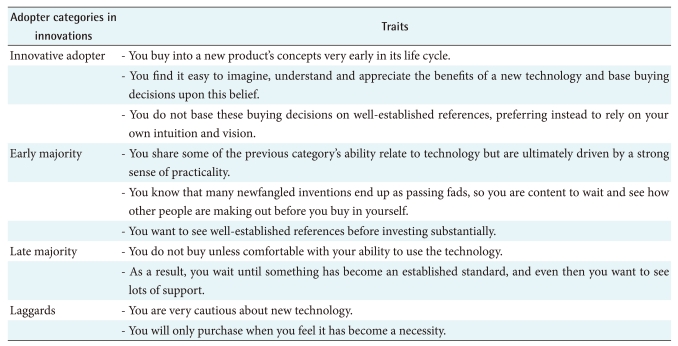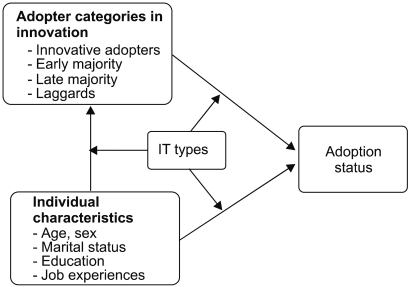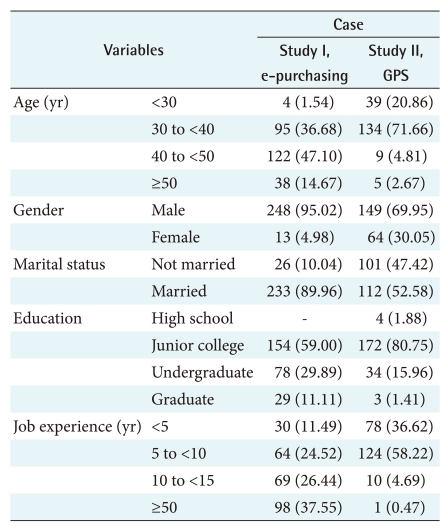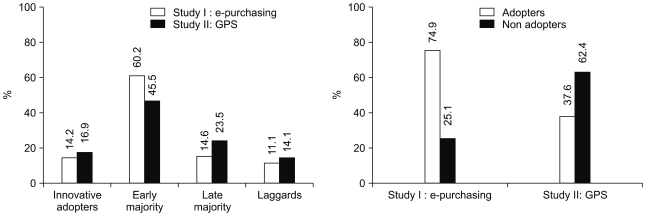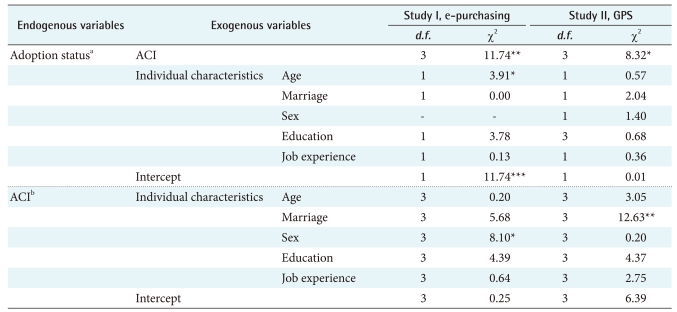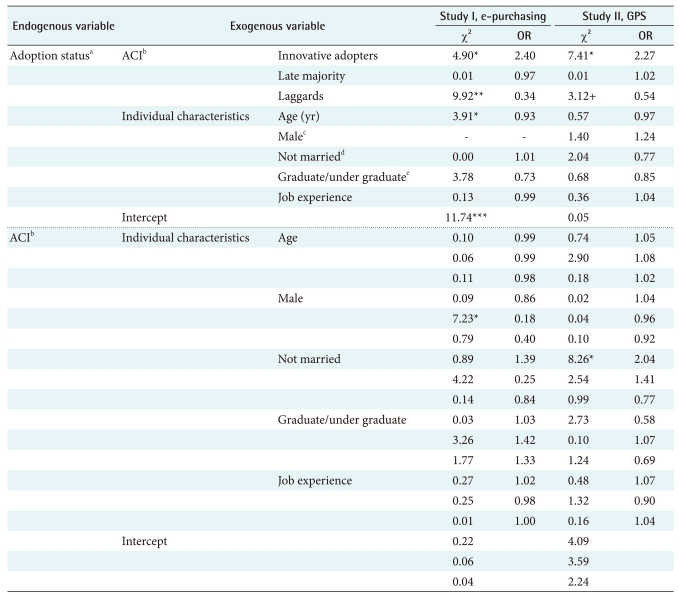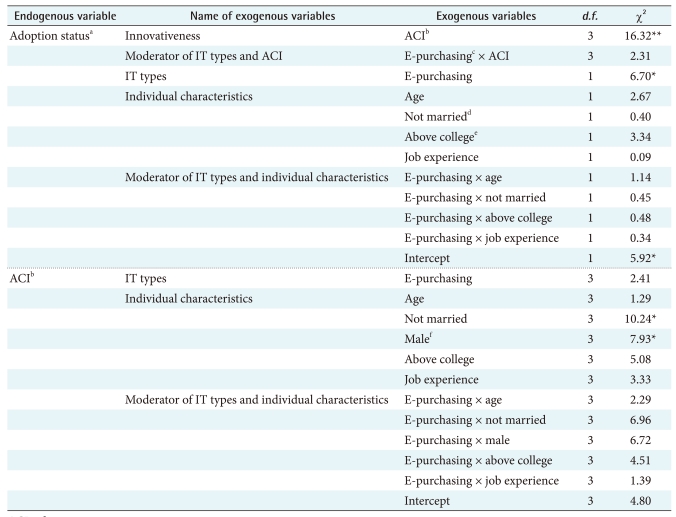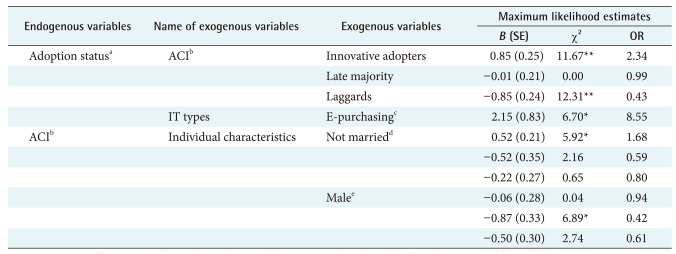Abstract
Objectives
The purpose of this study is to identify the role of individual innovation to demographic variables for determining IT adoption behaviors. This study also examines the effect of individual innovation on IT adoption behaviors across IT types.
Methods
To verify the invariant effect of individual innovativeness, two groups of persons working in the health care field were surveyed. The first study subject group was radiologists and their adoption of e-purchasing the second group was emergency rescue crews and their adoption of GPS.
Results
Adopter categories in innovations (ACI) as the measurement of individual innovation were a significant variable in both studies. Innovative adopters were more likely to use new IT tools than the majority of early adopters, and the early majority was more likely to adopt IT than the laggards. After merging the two data sets into one for testing the role of IT types as a moderator, the significance of ACI did not change, compared to the two separate analyses. In the merged data set, innovative adopters were 2.34 times more likely to be adopters than the early majority. The early majority was 2.32 times more likely to be adopters than laggards. Moreover, there were no moderating effects of IT types. Thus, there were no reversed adoption rates according to levels of ACI and demographic variables.
Conclusions
ACI has invariant effects on IT adoption behaviors regardless of IT types and demographic differences. To implement a new innovation, understanding individual innovativeness will provide more sophisticated implementation strategies for health care organizations and appropriate education programs for their employees.
Keywords: IT Adoption Behaviors, Adopter Categories, Innovation Diffusion, Individual Innovativeness, Moderator
I. Introduction
Korean hospitals are continuously investing in either their own information systems or a new innovative information technology for the purpose of improving health care quality and getting more cost effective ways for treating their patients. Currently, one of the biggest IT innovations by hospitals is electronic medical record (EMR). EMR usage percent was 20% in 2005, which was twice that of 1999 [1]. In this kind of innovation adoption, hospital management should evaluate how quickly their investments would achieve productivity and health care quality goals. An innovation adoption itself does not guarantee that organizations will achieve desired goals, unconditionally. For example, US business organizations had not found distinct evidence for productivity improvement until the 1990s, in spite of huge investments in information systems after 1970s, this is a phenomenon that has been called as productivity paradox [2].
It will be important to understand how IT innovations are adopted in either organization or individual levels, what kinds of mechanism are working in the adoption process, and why they want to either use or reject the innovations for their work purposes. Among these factors, employees' IT adoption or rejection behaviors should be the most important aspect, because the most urgent step for productivity enhancement starts from adopting and using any IT innovations. Moreover, in thinking about adoption behaviors, we need to identify what factors are the most important for adopting IT innovations.
The most eminent model on IT adoption behaviors is the technology acceptance model (TAM) [3,4], which is composed of two key determinants of behavioral intention, perceived usefulness and easy to use in terms of innovation characteristics. Using and applying TAM, many studies have investigated the determinants of behavioral intention for the IT of interest. In the Korean health care field, the studies [5-7] that were based on TAM reflected the key concepts of TAM relatively well and verified proposed path significances from perceived ease of use and perceived usefulness to usage intension. One study [8] adopted a variant approach, which assigned the final endogenous variable as satisfaction instead of behavioral intention. Moreover, rather than using behavioral intention as a final variable, one study [9] that investigated Web site usage behaviors tested and verified their hypotheses after specifying actual usage behaviors and loyalty to use as dependent variables and assigning usage intension as a mediator variable. However, even though all the above studies [3-9] considered two key innovation characteristics in their study models, they did not take into account individual innovativeness itself.
Rather than using Davis' key innovation characteristic variables, this study tires to testing the roles of individual innovativeness on IT adoption behaviors. Rogers' innovation diffusion theory [10,11] explains that personal traits as a predisposed individual characteristic is invariant across information technology types and is continuously influencing individual adoption decisions and behavior. Thus this study assumes that individual innovativeness directly determines actual IT adoption behaviors. In the most previous studies, usage intension was used as the dependent variable, because in behavioral intension could theoretically predict human behavior well. However, this study used actual adoption status as the dependant variable, which eliminates the assumption of the relationship between intension and behavior. This approach may give us more accurate results than using behavioral intension as the dependent variable. Moreover, without actual adoption and use of IT, the possibility for achieving an intended goal could not be expected.
For identifying the roles of individual innovativeness, this study selected e-purchasing behaviors and geographic positioning system (GPS) as the target technologies rather than the more current technologies with which subjects may not have adequate information. By studying the adoption of technologies that have been used for several years, the study subjects would be expected to have some information and experience with them. This allowed us to test the role of personal innovativeness on adoption behaviors in a natural social environment without intensive explanations or introduction sessions on the target technologies. Moreover, even this study selected two general IT innovations, the findings of this study may apply to understanding adoption and usage of physicians' EMR in hospitals because this study assumes that personal traits and character, personal innovativeness, can generally apply to adoption and usage behaviors of other IT innovations.
II. Methods
1. Study Subjects
To determine what factors affect IT adoption decisions, two groups of Korean health care workers have been studied. The first study was on the use of e-purchasing by radiology technicians to acquire medical supplies and items for maintaining and running MRI. The subjects were radiology technicians who were working at hospitals that registered their usage of MRI with the Korean Society of MRI Technology (KSMRT). A pilot survey was given to technicians at 20 hospitals, after which the survey was modified. Surveys were mailed to the other 506 hospitals by no more than one technician per hospital, followed by telephone calls to encourage the completion of the survey. The response rate was 49.6% (261).
In the second study, the subjects were emergency rescue crews at fire stations and first level emergency medical technicians at hospitals. The target technology was the use of GPS for their work purposes. One thousand twenty emergency workers in southeastern Korea were indentified through the statistics of National Emergency Management Agency and the roster of the Korean Emergency Medical Technician Association. A pilot survey was given to 40 workers, after which the questionnaire was modified. The questionnaire was sent by mail to 500 randomly selected emergency rescue workers, and 231 (46.2%) questionnaires were returned.
2. Study Model
The study model was designed for testing the effects of either individual innovativeness or individual demographic differences on IT adoption decision across IT types. Based on Rogers [10,11] innovation diffusion theory, this study assumed that different levels of innovativeness and demographic characteristics result in different adoption decision and behaviors. For measuring individual innovativeness, Rogers' adopter categories in innovations (ACI) was used, which have four distinct groups such as innovative adopter, early majority, late majority and laggards. On the theory, each group shares its' own unique characteristics and common values [11,12], as summarized in Table 1. Rogers also insisted that demographic differences may result in different adoption behaviors as well as ACI.
Table 1.
Characteristics of adopter categories in innovations
Moreover, the study model encompassed a concept of invariant effects of individual innovativeness across IT types, which means that each adopter group's values invariably influence on adoption decisions across two target information technologies. For testing invariant effects of individual innovativeness, this study will analyze the two data sets from two surveys separately and will compare the results of paths significances.
After assigning IT types as a moderator, this study will merge the two data sets into one and test moderating effects of IT types in predicting adoption behaviors (Figure 1). Through these moderations, this study can identify whether the adoption rates of each IT type are reversed by either ACI or individual demographic differences or not.
Figure 1.
Study model.
3. Analysis Method
This study selected categorical analysis method rather than using structured equation models, because the final endogenous variable has two digit categories of either adopters or potential adopters. In this case, we may use Partial Lest Square (PLS) analysis, which assumes non-parametric approach and test path significances of the study model. But this study wants to preserve parametric assumption by using logistic regression analysis. This study examined all proposed paths significances of the study model in both the two data sets separately for testing invariant effects of individual innovativeness and the merged data for testing moderating effects of IT types.
III. Results
1. Individual Characteristics and IT Usage Traits
Study subjects' average age was 42 and 32 in study I and II, respectively. In these two studies, percentage of male was larger than that of female, which might have been caused by their job characteristics. Approximately 90% of the subjects in the e-purchasing study were married, while about 50% of the subjects in GPS study were married. As for the job experience, the study subjects in study II have relatively less job experience, compared to study I (Table 2). The differences of rate of marriage and job experience may have been caused by the differences of age in these two studies. The study subjects in study II were younger than those in study I and then, they had relatively shorter work experience and also would spend some more years before getting married.
Table 2.
Individual demographic characteristics
GPS: geographic positioning system.
74.4% and 45.9% of study subjects were early majority and innovative adopter in study I and II, respectively. As expected with more innovative adopters and early majority, there was a greater level of adoption. In study I, 74.9% of the subjects were adopters, but 37.6% in study II (Figure 2).
Figure 2.
Distributions of ACI and adoption status between study I and II. ACI: adopter categories in innovations, GPS: geographic positioning system.
2. Invariant Effects of ACI on Adoption Decisions by IT Types
This study examined invariant effects of ACI across IT types. In the maximum likelihood analysis of variance (Table 3), ACI significantly determined adoption status in both studies. Moreover, all individual characteristics were not significant except age in study I. But as the determinant of ACI, sex and marital status were significant at α = 0.05 (Table 3). In the analysis for study I, sex was excluded for explaining ACI due to the insufficient response rates from females. For testing ACI group differences, early majority was assigned as a reference group (Table 4). Innovative adopters were 2.40 and 2.27 times more likely to be adopters than early majority in study I and II, consecutively. In the influence of individual characteristics on ACI, sex was significant in study I, but marriage was significant in study II.
Table 3.
Maximum likelihood analysis of variance by IT types
GPS: geographic positioning system, ACI: adopter categories in innovations.
anone adopters, bearly majority, *p < 0.05, **p < 0.01, ***p < 0.001.
Table 4.
Maximum likelihood estimates by IT types
GPS: geographic positioning system, OR: odds ratio compared to the reference group, ACI: adopter categories in innovations.
anone adopters, bearly majority, cfemale, dmarried, ejunior college/high school, *p < 0.05, **p < 0.01, ***p < 0.001, + 0.07.
Based on the above results, similar patterns of results were identified in study I and II and there were no big differences on the effects of ACI on adoption status caused by specific IT types. Some individual characteristics make differences on ACI but not adoption status. Thus, the effects of ACI on adoption status are not either IT type specific or IT dependant, but regardless of IT types, ACI can generally explain IT adoption behaviors.
3. Moderation Effects of IT Types
To test moderation effects of IT types on adoption status, data from two studies were merged and IT types were treated as an independent variable. ACI was also the significant determinant of adoption status, and all individual characteristics were not the significant determinant of adoption, but two demographic characteristics (i.e., sex and marital status) significantly determined ACI (Table 5). Moreover all moderating effects were not significant, which means that there were no reversed adoption rates across IT types in either each adopter category or demographic characteristics.
Table 5.
Maximum likelihood analysis of variance for testing moderating effects
ACI: adopter categories in innovations.
anon adopters, bearly majority, cGPS, dmarried, ebelow college, ffemale, *p < 0.05, **p < 0.001.
In maximum likelihood estimates for the study model (Table 6), innovative adopters were 2.34 times more likely to be adopters than early majority and early majority were 2.32 (1/0.43) times more likely to be adopters than laggard after controlling IT types. These were statistically significant at α = 0.01. In the effects of demographic characteristics on ACI, those who did not marry are 1.68 times more likely to be innovative adopters than early majority, and male compared to female were 2.38 (1/0.42) times more likely to be early majority than late majority, which were statistically significant at α = 0.05. In the Table 6, most of non-significant variables were not shown for the purpose of simplification, even though the full study model with all variables was analyzed.
Table 6.
Maximum likelihood analysis of estimates for testing moderating effects
Some non-significant variables in the study model were erased in this table for the purpose of simplification.
ACI: adopter categories in innovations, OR: odds ratio, SE: standard error.
anon adopters, bearly majority, cGPS, dmarried, ebelow college, efemale, *p < 0.05, **p < 0.001.
IV. Discussion
Based on Roger's [10,11] innovation diffusion theory, this study assumed that different innovative traits result in different IT adoption behaviors because each adopter group shares unique and common values, and differences of demographic characteristics also influence the differences of adoption behaviors and ACI. By selecting two different work professionals and IT types, this study also examined the invariance effects of ACI on adoption behaviors across two IT types. In the previous studies on IT adoption behaviors, demographic characteristics that influence IT usage were sex [13-15], age [13] and education level [16]. Even these previous studies were relatively more focused on explaining behavioral intensions rather than actual behaviors, this study adopted these variables as key components for explaining either actual usage behaviors or ACI. However, for explaining adoption status, all demographic characteristics of study I and II were not significant, but only age was significant in study I. In the merged data from study I and II, individual characteristics also were not significant and have no moderating effects with IT types. This result can be interpreted as their professional norms are more dominant over demographic differences in explaining individual innovativeness because legal requirements for getting their licenses and working within their professional job specifications may enhance their norms and make them more homogenous groups.
In explaining ACI, sex and marital status were significant. These results partially conform to the assertions of Roger [10], which insists that socioeconomic, communication behaviors and personality variables are related to ACI. Sex and marital status were significant, which can be linked to communication behaviors and personality. If males have more active communication networks and behaviors than females, males are more likely to be early majority than late majority compared to females, because Rogers [10] insists that communication behaviors are positively related to higher levels of ACI. Moreover, assuming the unmarried person are more likely to take a more favorable attitude toward change, science and education, Rogers' assertion was also verified with this result because of higher rates of innovative adopters in the unmarried persons, compared to the married.
This study identified that the differences of individual innovativeness determines IT adoption status after controlling demographic variables. In study I and II, innovative adopters were more likely to be adopters than early majority, and laggards were less likely to be current users than early majority. After considering IT types as a confounding variable, the significances of ACI were not changed. The odds of being current users in innovative adopters and early majority were higher than early majority and laggards, respectively. These results practically verify Roger's innovation diffusion theory [11] in Korean health care fields, which assumes that when people are exposed to new technologies or ideas, their underlying natures toward innovations thoroughly reflect their behaviors. Moreover, by identifying the similar results in study I and II, this study found the invariant effect of ACI on adoption behaviors.
In the previous studies, there was no study that examined the relationship between individual innovativeness and current adoption status. Yi et al. [17] identified the role of ACI for determining behavioral intensions. They found that ACI positively influences innovation characteristics (i.e., usefulness, ease of use and compatibility) that simultaneously determined behavioral intension, and ACI also directly influences behavioral intension, which implies that the effect of ACI was partially mediated through innovation characteristics. However, if we assume theoretically closer relevance between behavioral intension and actual behaviors, the results of Yi et al.'s study [17] and this study could be treated as a similar result. But this study attempt to eliminate the assumption by using actual adoption behaviors as the final endogenous variable. In a study using actual usage as the endogenous variable, Song et al. [9] used actual Web site usage. The Web site usage was determined by behavioral intension that was also influenced by usefulness. Thus this study, rather than testing innovation characteristics as a determinant of behavioral intensions, seeks to test how individual innovativeness itself works on adoption behaviors across IT types.
All moderating effects caused by IT types were not significant, which means that study subject technologies in each study are located at a similar position on IT adoption life cycle, and all demographic variables did not have any interaction effects with IT types. More specifically, the adoption rates of either each adopter category or demographic characteristics were not dramatically reversed by IT types. This result implies that ACI is the key determinant of adoption behaviors after considering the moderator (i.e., IT types) and individual demographic differences. In other words, regardless of IT types and demographic variables, ACI significantly influences personal IT adoption behaviors. These results partially conforms to the results of Yi et al.'s study [17], which tested moderating effects of ACI with main effects of innovation characteristics (i.e., usefulness, ease of use and compatibility), but this study sought to test the moderating effect of IT types with the main effect of ACI in explaining actual adoption behaviors. In both studies, there were no moderating effects.
For measuring individual innovativeness, this study used ACI, as Moore and Benbasat [18] proposed, which assumes that each individual has distinctive traits and belongs to one category in using IT innovations. In the other approach, Agarwal and Prasad [19] proposed five point Likert scales in terms of personal innovativeness in the domain of IT (PIIT). But this approach just gives the amounts of individual innovativeness, but not behavioral traits in a group. Thus, this study insists that ACI has more advantages for understanding IT adoption behaviors than PIIT. ACI can identify an individual's behavioral characteristics, which provide us with information about organizational IT implementation strategies for improving work efficiency.
The implication of these results is that individual innovativeness is a crucial element for understanding IT adoption behaviors. In a practical situation of EMR adoption and use, identifying individual innovative traits of health care professionals, hospitals may prepare and launch more sophisticated system diffusion strategies and system education classes, which can assure health care information system success. For example, if one organization, like the subjects of study I, has relatively more people in innovative adopters and early majority categories than the other categories, system education classes for their employees might be a more effective approach than a motivation program to use the new IT, because most employees are already internally motivated by themselves without extrinsic motivations in adopting and using the new IT. In the opposite situation, if there are significant portions of employees in late majority and laggards, the organization needs to design a motivation program for enhancing their adoption intensions and usages by introducing practical effects, gains, and instrumental functions after adopting and using the new IT.
In conclusion, this study verified, based on Roger's innovation diffusion theory, that adopter categories in innovations determined current adoption behaviors in the health care field. Moreover, this study also found that the influences of individual innovativeness exist in two types of information technology. In future studies, if more various types of IT are subject to testing, we would achieve more generalized results about the roles of individual innovativeness on IT adoption behaviors in health care fields. Moreover, a future study with Rogers' all personal innovative characteristics in study models, the findings might give us more broad perspectives on understandings IT innovations adoptions and usage behaviors.
Footnotes
No potential conflict of interest to this article was reported.
References
- 1.Chae YM. Analysis of international trends in health information systems and its implication for national policy in Korea. Seoul: Ministry for Health, Welfare and Family Affair; 2005. p. 208. [Google Scholar]
- 2.Kim MY. Productivity paradox of ICT: debates revisited and policy implications. Product Rev. 2002;16:169–185. [Google Scholar]
- 3.Davis FD. Perceived usefulness, perceived ease of use, and user acceptance of information technology. MIS Q. 1989;13:319–340. [Google Scholar]
- 4.Davis FD, Bagozzi RP, Warshaw PR. User acceptance of computer technology: a comparison of two theoretical models. Manage Sci. 1989;35:982–1003. [Google Scholar]
- 5.Park JS, Park KS. Human-technology integration for implementing electronic approval system in a hospital. Korean J Hosp Manage. 2002;7:102–120. [Google Scholar]
- 6.Park HA, Yun EK. The impacts of consumer's subjective health literacy on health websites acceptance and empowerment. J Korean Soc Med Inform. 2006;12:293–304. [Google Scholar]
- 7.Shim JW, Paik SK, Han IG, Ryu SW. Influencing factors of physician's intention to use cyber salesperson of ethical drugs. Korean J Hosp Manage. 2009;14:124–148. [Google Scholar]
- 8.Chang H. Application of the extended technology acceptance model to picture archiving and communication systems in dental hospitals. J Korean Soc Med Inform. 2009;15:265–272. [Google Scholar]
- 9.Song T, Um K, An J. The development of an evaluation model for the acceptability of health information websites. J Korean Soc Med Inform. 2005;11:221–233. [Google Scholar]
- 10.Rogers EM. Diffusion of innovations. New York: The Free Press; 1995. [Google Scholar]
- 11.Rogers EM. Diffusion of innovations. New York: Simon & Schuster; 2003. pp. 1–150. [Google Scholar]
- 12.Brancheau JC, Wetherbe JC. The adoption of spreadsheet software: testing innovation diffusion theory in the context of end-user computing. Inf Syst Res. 1990;1:115–143. [Google Scholar]
- 13.Igbaria M. User acceptance of microcomputer technology: an empirical test. Omega. 1993;21:73–90. [Google Scholar]
- 14.Gefen D, Straub DW. Gender differences in the perception and use of e-mail: an extension to the technology acceptance mode. MIS Q. 1997;21:389–400. [Google Scholar]
- 15.Venkatesh V, Morris MG. Why don't men ever stop to ask for directions? Gender, social influence, and their role in technology acceptance and usage behavior. MIS Q. 2000;24:115–139. [Google Scholar]
- 16.Agarwal R, Prasad J. Are individual differences germane to the acceptance of new information technologies? Decis Sci. 1999;30:361–391. [Google Scholar]
- 17.Yi MY, Fiedler KD, Park JS. Understanding the role of individual innovativeness in the acceptance of IT-based innovations: comparative analysis of models and measures. Decis Sci. 2006;37:393–426. [Google Scholar]
- 18.Moore GC, Benbasat I. Development of an instrument to measure the perceptions of adopting an information technology innovation. Inf Syst Res. 1991;2:192–222. [Google Scholar]
- 19.Agarwal R, Prasad J. A conceptual and operational definition of personal innovativeness in the domain of information technology. Inf Syst Res. 1998;9:204–215. [Google Scholar]



